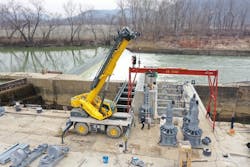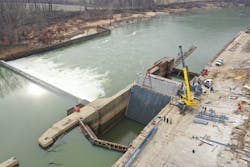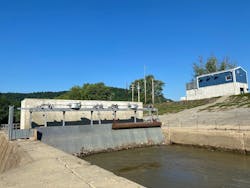A Smart Solution for a Small-Scale Hydroelectric Power Project
About the author:
Asad Choudry is Director of Product Management for Flygt Great & Grey Pumps & HydroTurbines with Xylem. He has more than 19 years of experience within applications, product and project management disciplines with various pump-technology organizations. Asad holds a Bachelor of Science in Mechanical Engineering with a specialization in Aerospace from Hofstra University with a profound interest in innovative technology and digital solutions. He is considered an expert for pumps and condition monitoring systems within wastewater and stormwater.
Xylem Supports the Development of a Custom Hydroelectric Station to Power Local Communities
Renewable methods of power generation are becoming increasingly common across the U.S. as federal and state tax incentives increase and caps on carbon dioxide emissions make traditional fuels a more expensive option. This holds true even in traditionally coal-dominated states like Kentucky. Although it lacks the abundant wind or sunshine necessary for wind and solar power, Kentucky has the assets needed to generate hydroelectric power. The southeastern state boasts substantial and consistent rainfall and many rivers, most of which are already dammed for navigation, flood control or recreation. Hydropower is America’s largest source of clean, renewable electricity, accounting for 52% of the nation’s renewable electricity generation and 7% of total electricity generation.
Harnessing the Power of Hydro
The U.S. Department of Energy has identified small, low-head dams as a significant source of potential renewable energy generation. However, this re-development, using conventional equipment and technology, has not yet proven financially viable.
Appalachian Hydro Associates (AHA) based in the town of Ravenna, Kentucky is aiming to change that by developing a more cost-effective model for small hydro projects. In 2015, the Federal Energy Regulatory Commission issued a license for a hydroelectric project on Lock 12, not far from Ravenna.
According to AHA President David Brown Kinloch, Ravenna was once a major hub with all the coal mined in Eastern Kentucky passing through the town. “Boats used to bring coal down river to market from up in the mountains,” he explained. Lock and Dam 12 opened to navigation in 1910 and remained open to commercial traffic into the 1990s. By then many of the locks were abandoned as rail and highways offered faster and cheaper means of transport.
The ability to place hydro turbines in the existing lock chamber helped to dramatically reduce project costs. However, AHA still needed a partner to help offset the upfront investment costs.
“We needed to find a partner with a long-term perspective,” Brown Kinloch said. “In our case Berea College was the perfect partner.”
Berea College, a private, Christian, liberal arts work college located in Berea, Kentucky, has a commitment not only to the environment and sustainability, but also to the community of eastern Kentucky.
With Berea College on board, AHA turned to Xylem to help design the hydroelectric power solution driven by submersible hydro turbines. Submersible turbines are extremely adaptable and can be designed to work in almost any site. With low initial investment cost and proven pump longevity, the return on investment in small scale hydro is short, supporting strong profitability.
Modular Hydro Turbines
Before construction began, Dr. Lyle Roelofs, president of Berea College and members of the Berea College’s executive team traveled to Xylem’s Flygt manufacturing base in Sweden to see the hydro turbines being manufactured first-hand.
At just 52 feet wide, the lock chamber is relatively narrow. To overcome this challenge, Xylem engineers suggested the semi-Kaplan hydro turbine - a modification of a standard Flygt hydro turbine pump to suit the limited space available. The semi-Kaplan hydro turbine features a custom modular design especially for water locks, with a draft tube that is narrower and taller to regain some losses and increase the efficiency of the turbine. The slim diameter of the Xylem pumps meant that five, large hydro turbine pumps could fit within the chamber.
“We needed something that was at the right scale,” said Dr. Roelofs. “There are very few manufacturers serving this market, but it’s a very important one because small scale hydro is going to be one of the futures of sustainable electric production.”
It’s also the first new small hydro plant to use variable speed technology, which allows the turbines to generate about 10 to 15% more power than traditional hydropower. The generators have an efficiency of 96.8%, giving the units an overall efficiency of 81.1%. The Flygt turbine generators are designed to last 50 years, twice as long as solar and wind plants. Polyset, the same zinc silicate coating used on U.S. Navy aircraft carriers, prevents rust on the plant’s turbine generators as the coating forms a chemical bond with the steel and creates an impermeable glass-like surface.
Throughout the construction of the Lock 12 hydroelectric power plant, heavy rains plagued the project, causing frequent delays. Xylem’s extensive dewatering expertise and powerful Godwin dewatering pumps ensured the project site was clear of unwanted water while concrete for the supporting structure was poured.
Making Clean, Inexpensive Power
After two years of construction, the 2.64 megawatt (MW) Ravenna Hydroelectric Project went online in June, 2021. Most of the flow of the Kentucky River passes through the hydro turbines, each producing up to 500 kilowatts (KW) of energy, which flows into and is sold to the Jackson Rural Electric Cooperative. In turn, it is a revenue resource for Berea College. The amount of power generated is approximately half of the amount used on the college campus.
“To put it in perspective, we’ll probably be making enough electricity for about 1,200 average Kentucky homes,” Dr. Roelofs explained.
In addition to reselling the equivalent of 50% of the power the campus uses to the local co-op, Berea College will continue to purchase electricity from Berea Municipal Utilities. This kind of use of resources allows for economic development in the area by supporting jobs and providing renewable energy in Kentucky.
“What I really like about this project is that it speaks to Xylem’s core values of solving water and creating electrical power through a natural resource of the river,” said Doug Billiter, sales representative, Xylem.
According to Jillian Davis, the project’s design engineer with Kleinschmidt Associates, a consulting firm that specializes in providing hydropower engineering, regulatory and environmental services, “This is a really repeatable process.”
With at least 14 lock structures on the Kentucky River, AHA now has a hydroelectric power solution that can be easily replicated in other lock structures located upstream or downstream with minimal re-engineering necessary. With plans to install hydroelectric power plants in at least four more lock structures on the upper Kentucky River, Dr. Roelofs said hydroelectric power projects like Lock 12 are bringing hope to an area that has been economically depressed since the coal industry downturn.
“This is a new kind of use of the natural resources,” Dr. Roelofs explained. Brown Kinloch agreed. “We’re making good, clean, inexpensive power that we can sell to the rural electric cooperative at a discount, so their members are saving money,” he said. “At the same time, we’re benefiting Berea College and their students.”
The power generated will be sold primarily to Jackson Energy Cooperative at a discounted rate and will power 1,200 homes in the West Irvine area. The Estill County public schools will benefit from property taxes generated by the project.
Berea College is the first higher education institution in the U.S. to complete construction of a hydroelectric generating plant.
“This project is good in so many ways,” said Dr. Lyle Roelofs, president of Berea College. “We serve students from all of the counties of Kentucky, including Estill County where the project is and Jackson County where the electricity is going. Just the fact that we’re creating half of the energy we use on campus without burning a lick of coal is the biggest plus in all of this.”
The $10.2 million energy project, named the Matilda Hamilton Fee Hydroelectric Station after the first “First Lady” and a co-founder of Berea College, is the result of a collaboration with Appalachian Hydro Associates (AHA), which provided the engineering and regulatory expertise needed to complete it. Other entities involved in the project include the Kentucky River Authority, Jackson Energy Cooperative, Wright Concrete & Construction of Pikeville, Kleinschmidt Associates, and Xylem.


